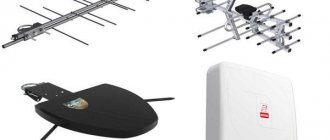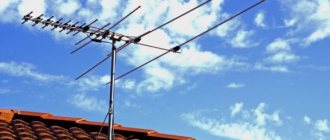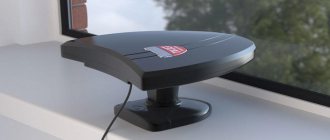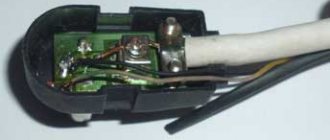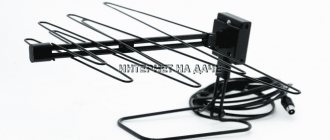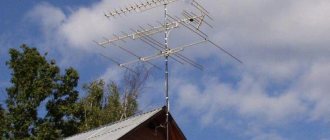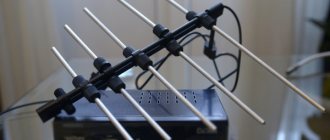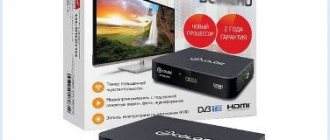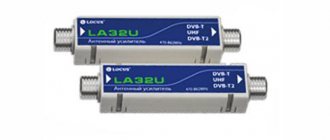Do you want to start watching T2 digital television in your country house? You will need the right antenna to receive DVB T2 digital television at your dacha. Don’t know which one to install, are there problems and uncertainties with digital television outside the city? This article is for you, because an antenna is the most effective, best way to solve these problems, and very often the only one.
If your digital television reception turns out to be poor, and you do not have practical experience to ensure good reception, then read the article carefully, and most importantly, try to follow the recommendations you have read.
Types of antennas
What is the most important thing for confident, stable reception of digital television? Antenna. It doesn’t matter where your country estate is located, to receive a digital signal you will have to work hard when choosing a television antenna for your dacha. There is no job more stupid and unnecessary than trying to receive a digital signal outside the city with an indoor antenna. Only the lucky ones will be able to watch digital television on an indoor antenna without any problems, and only if it is located in an area of reliable reception, near a TV tower or repeater.
The most powerful indoor antennas
Indoor antennas operate in several bands - meter or decimeter, providing signal reception at a distance of up to 30 kilometers. Of course, indoor antennas are characterized by the presence of certain limitations in the quality of television waves, therefore, to obtain a normal picture, it is necessary to carefully configure each channel.
However, indoor antennas for receiving digital television have their advantages. Firstly, compact dimensions should be highlighted. Secondly, I am pleased with the relatively low cost. The undisputed leader in the TV antenna market is the Remo company.
A rating of DVB-T2 digital television antennas has been compiled especially for you. Experts have selected the best devices with an optimal price/quality ratio.
Remo BAS-5310USB Horizon
If you have not yet made a choice of antenna for DVB-T2, then it’s time to pay attention to this model, because it is the one that tops our rating. The original appearance is a significant, but by no means the only advantage of the device.
Its compact size and convenient mounting allow you to place it on your TV. Provided that the setup is done correctly, it will receive waves from different channels in the range 21-69. The amplifier is built-in, which has a positive effect on the quality of the received signal.
If you study the reviews of domestic consumers, you can find a lot of positive comments. Most often, users note high quality reception and convenient connection via a USB connector. The antenna is capable of working with a reflected signal. The durable case is made of high-quality material, so the protection of hardware parts from mechanical damage is thought out to the smallest detail. There shouldn't be any difficulties connecting. The weight is only 230 g. The equipment is equipped with a 5 Volt power adapter, which is also included in the kit. If we talk about shortcomings, there is only one – a short power supply cord.
Harper ADVB-2120
The second device goes to a model from the popular manufacturer Harper. It’s not surprising, because it has a colossal amount of positive reviews from Russian consumers. Firstly, we should highlight the fact that the device picks up frequencies in a wide range - 87.5-862 MHz. Secondly, you can configure not only digital TV, but also analog TV.
It’s hard not to notice the original design, which is also important. After all, this is an indoor TV antenna, which means it will always be in sight. The amplifier is powered directly from the TV or set-top box, since it does not have a separate network adapter. Of course, this causes restrictions on the use of equipment. But the device boasts compact dimensions.
The ergonomics of the Harper ADVB-2120 are also excellent - if necessary, the TV antenna can be placed on a flat surface. The shape of the closed ring allows you to hang the device on a bracket or hook without much difficulty. If you take into account all the previously listed technical advantages, as well as the relatively low cost, it becomes clear why this model is included in the list of the best. [catalog_item id=”2447″]
Remo Inter 2.0
Third place goes to a model that features impressive functionality and a relatively low price. Therefore, it is not surprising that this device holds its position in this segment.
The receiver is designed to connect 20 digital and 10 analog channels. An intuitive control system allows you to set the required level of signal amplification to achieve the highest possible quality.
Buyers also list the harmonious design and the simplest installation process as its main strengths. The device body is dismountable, assembly takes just a few minutes. Special attention should be paid to the power adapter cable - it has good insulation. Also, the unit wire and the TV antenna are approximately the same size, so they can be easily placed in a convenient place. If we talk about shortcomings, there are only two of them. The quality of the plastic from which the equipment is made leaves much to be desired. The second disadvantage is problems with signal reception; it is by no means always stable.
Active and passive analog antennas
The antenna for a TV in the country can be active or passive. If a traditional external one has a box into which the antenna cable goes, and the box itself contains a matching board (balun), then it is passive. If you are using a garden antenna with an amplifier to which power is supplied, then it is of the active type.
Power supply for amplification board 12 V 0.5 A
Rating of home antennas for TV without an amplifier
Such antennas provide a good signal near towers, provided there are no obstacles that affect the signal quality. Also, such antennas significantly save energy consumption and thereby save the family budget.
The best indoor antennas for digital television without a built-in signal amplifier are:
REXANT RX-107-4
This four-section antenna is designed to receive analog television signals and VHF-FM broadcast stations. Its power type is passive, which means a minimum level of energy consumption. The small size of the antenna allows you to easily install it in a room. Dipoles, telescopic whiskers, can be adjusted in height, thereby adjusting the quality of signal reception in the MV range.
| Characteristic | Meaning |
| Frequency range | 47-220 MHz |
| Gain indicator | 2.5-5 dB |
| Dimensions | 30x80x350 mm |
pros
- very low cost;
- adjustable height;
- availability of adapter;
- twelve months warranty;
- any user can install it independently without any problems.
Minuses
- lack of reviews;
- flimsy design.
Ritmix RTA-001
A telescopic passive indoor antenna allows you to receive various digital HD TV standards for terrestrial television, including the new Russian digital TV standard - DVB-TV2. This model without an amplifier provides high-quality reception of analogue and digital television signals, as well as reception of radio signals with FM frequencies. Telescopic guides are height adjustable from 4 to 80 cm.
| Characteristic | Meaning |
| Frequency range | 470-862 MHz |
| Gain indicator | 5 dB |
| Dimensions | 350x80x30 mm |
pros
- the build quality and components are at a good level;
- there is a radio signal output;
- can work both vertically and horizontally;
- official service life is two years, of which one year is under warranty;
- supports several TV broadcast standards.
Minuses
- cable length is only 1 meter;
- moisture must be avoided.
Review: “This is a regular v-shaped passive indoor antenna that is inserted into a hole in the TV body. It is worth buying this antenna for a simple TV. Necessary just in case."
D-COLOR DCA-109
A passive home antenna for digital television receives an analog signal within an area of reliable coverage. A high gain of up to 7 dB (as for passive antennas) provides high-quality picture and sound without distortion or freezes. Modern design and the ability to place the device on a table or shelf will definitely appeal to lovers of minimalism. The manufacturer, a leading supplier of digital set-top boxes to the Russian market, provides a three-year warranty for this model.
| Characteristic | Meaning |
| Frequency range | 40-862 MHz |
| Gain indicator | 5-7 dB |
| Dimensions | 60x260x60 mm |
pros
- extended warranty period;
- affordable price;
- the gain is higher than that of other antennas of the same type;
- thoughtful design;
- light weight - only 100 grams.
Minuses
- fragile plastic;
- short cable.
Review: “Low price, good reception for an antenna without an amplifier. If the TV tower is nearby, then you can take it.”
Antenna for receiving digital television in the country
It's time to find out that a digital antenna for a summer residence is a marketing fiction. There are no “digital antennas”, “digital cables”, “digital amplifiers”. There are over-the-air antennas, coaxial cables, and antenna amplifiers. Their parameters and cost do not correlate in any way with either digital or analogue TV standards.
A special antenna for digital is an advertising scam. For digital TV in the country, ordinary decimeter (UHF) or broadband antennas (MF-UHF) are suitable.
And yet, what kind of antenna should I put in my dacha for long-distance reception? Multi-director at the highest possible height, precisely aimed at the broadcast tower, will give the best result. As a general rule, longer antennas with more bars (these bars are called "directors") provide much better reception than shorter ones.
Long range antenna
The most powerful outdoor antennas
Outdoor antennas for digital TV DVB-T2 have maximum power, which can be achieved through a special design. As a result, the device receives a signal even when located at a distance of up to 50 kilometers from the transmitter.
Of course, you should also take into account all sorts of obstacles that are in the path of the signal - naturally, they sometimes block television waves. Mostly experts recommend buying models with a built-in amplifier.
The TOP outdoor antennas for TVs will consist of only two models. Let's get to know them better.
Remo "Kolibri-A-DX Deluxe"
The receiver is located on a special mast, which improves signal reception. To increase the effect, an amplifier is used, which helps to receive TV channels even at an impressive distance. The model has an extremely successful design, thanks to which it perceives signals even in those regions where the tower is not in line of sight.
You can find a huge number of positive comments on the Internet. Consumers note stable and high-quality reception, as well as the simplest setup and installation. The most powerful digital TV antenna is powder coated to provide adequate protection against corrosion.
The package includes a 6-meter cable and an amplifier power adapter. There are certain weaknesses. For example, users note that adjusting the amplifier's operating parameters is very inconvenient. The reliability of the power supply also raises questions. [catalog_item id=”2421,2494,2429″]
Remo "Dvina-DX"
Despite its relatively low cost, during operation it demonstrates an impressive level of signal reception. Experts note that the device can be used to receive a signal at a distance of up to 50 kilometers. To increase the quality of wave reception, the developers equipped the model with a built-in amplifier. A 12 Volt power adapter is also included in the package.
After studying consumer reviews, it becomes clear that the main advantages of the TV antenna include excellent wave reception, low price and maximum ease of operation. During the production process of the device, special attention was paid to the quality of materials. For example, the support rod is made of lightweight but very durable aluminum, and the receiving elements are powder coated to prevent premature failure of the receiver.
Powerful fasteners will ensure reliable fixation of the structure on the bracket. There are also certain disadvantages. The fact is that users experience certain difficulties during the installation process. You also have to independently upgrade the separator for maximum quality work.
TV signal parameters
Level is an indicator of how strong the digital television signal is at the tuner input. The level is not determined by you or its seller. In the menu of any terrestrial digital tuner there is a function that shows you the signal strength.
You may be interested in: What does an HDMI cable look like?
Quality is the main indicator for which you will have to tinker with the antenna. It shows how suitable a TV signal is for digital decoding without errors. The digital tuner calculates the quality itself and can show it to you through its menu.
Signal level on the set-top box
Having set the frequency of the multiplex you need, you will see the level and quality of the signal graphically displayed on the TV screen. And then, by turning your antenna in different directions, and also installing it in different places, you can evaluate how these parameters change.
It is extremely important to correctly place the antenna in the country house. 1-2 meters in any direction and the reception can change a lot. The higher the antenna is located, the better. The further away from large metal objects, the better.
comparison table
| Name of product | UHF frequency range | Gain level indicator | Dimensions |
| Locus L 941.10 CAYMAN | 470-860 MHz | 11-18 dBi | 268x300x85 mm |
| HARPER ADVB-2969 | 470-862 MHz | 30 db | 150x150x203 mm |
| Selenga 101A | 174-862 MHz | 33.0 dBi | 190x110x8 mm |
| REXANT RX-267 | 470 – 862 MHz | 26 dBi | 270x350x120 mm |
| HARPER ADVB-1420 | 470-862 MHz | 30 dB | 183x234x130 mm |
| REMO BAS-5340-USB TVJET | 470 – 862 MHz | 23-43 dBi | 270x350x120 mm |
| Ritmix RTA-101 AV | 470 – 862 MHz | 32 dB | Length 600 mm |
| REXANT RX-107-4 | 47-220 MHz | 2.5-5 dB | 30x80x350 mm |
| Ritmix RTA-001 | 470-862 MHz | 5 dB | 350x80x30 mm |
| D-COLOR DCA-109 | 40-862 MHz | 5-7 dB | 60x260x60 mm |
Reasons for signal deterioration
What should you do and what not to do in order to receive a more or less high-quality digital signal and not degrade it?
First, do what you need to do to get the best possible antenna signal. A high-quality, narrowly directional antenna for a TV in the countryside is placed further and higher from large metal objects. It is advisable that there are no very high obstacles on the imaginary line from the antenna to the television transmitter: hills, waste heaps, tall trees. Install your antenna away from the iron roof of your country house, and in no case - under the iron roof itself, then there is guaranteed to be no digital television reception.
To avoid degrading the received signal, lay the cable correctly:
- don't use the cable you bought when your grandfather went to first grade;
- Don't buy the cheapest cable with virtually no braid. Choose normal cables;
- Do not shorten the cable as much as possible;
- do not make sharp bends in the cable;
- Do not twist the excess cable into a coil.
Even if you connect pieces of cable with a standard coaxial connector, the signal quality is guaranteed to deteriorate.
You can see how to strip the cable here.
The most powerful satellite dishes
Satellite dishes are perhaps the most modern and innovative solution. Firstly, they differ in the maximum range of received signals. Secondly, they provide the highest level of quality. However, dishes are much more expensive than other types of antennas. Let's look at the best antennas for digital TV.
Lans-65 MS6506
The main distinguishing feature is an excellent signal regardless of weather conditions. Made in China. Cost – 2500 rubles. The plate differs from analogues in its very non-standard design. The parabola geometry and special perforation allow it to stand out significantly from the rest.
As a result, the device cleans itself; of course, this has a positive effect on the quality of received information. Moreover, perforation helps to significantly reduce the wind load of the structure, making it lighter.
In their reviews, users note a pleasant design, excellent reception quality and an intuitive settings system. High-quality powder coating of metal elements protects the plate from premature failure. Reinforced mount allows you to adjust the angle of inclination. The waves jump periodically - this is the main drawback of this model.
AUM STV-0.6 DF-1.1
The Belarusian manufacturer managed to create a high-quality device with the best reception of NTV+ and Tricolor signals. Cost – 1150 rubles. The undisputed leader is this dish antenna, which is ideal for the above providers. Therefore, if you are their subscriber, you can safely buy the device.
The TV antenna shows excellent gain, which ensures effective operation even in densely built-up areas, this is very important for an external receiver. A distinctive feature is the design. The plate is shaped like an egg, which significantly improves reception.
In reviews, domestic consumers note the high quality of the material from which the popular TV antenna is made. It costs less than Chinese devices and has a simpler settings system. If necessary, you can safely replace the standard mount with a longer rod to improve the quality of signal reception. Additional components were made in haste - this is the only drawback of the device.
Using the amplifier
TV signal amplifiers
Why an amplifier at all? It compensates for signal loss on the cable. In fact, its necessity is conditional. Only the antenna receives the signal, and the signal quality depends only on it. But by the time the signal travels along a long cable to the tuner, it will weaken significantly. If the outdoor antenna for the dacha is installed at a considerable distance from the TV, for example, 30-40 meters or more, in this case the amplifier comes to the rescue.
If at your dacha the signal from the broadcast tower is strong enough, then its losses in the cable are insignificant. But if it is relatively weak, it is important to preserve the entire signal received by the antenna. Therefore, it is amplified using an antenna amplifier, and then, amplified, it goes through the cable to the tuner.
You may be interested in: The first advertising on television in the USSR and Russia
Antenna assembly
Let's remove the insulation from a piece of wire one meter long.
I got a wire with a diameter of 4.5mm
The tools you will need are a vice and a hammer. Measure approximately 11cm each and bend at an angle of 90°
The end result is to get such a “geometric” figure 
We cut off the excess and solder the ends. It should look something like this...
Solder the cable as shown in the photo.
We lay the cable along one side of the square and secure it with clamps. This arrangement of the cable is necessary for its coordination (there are different opinions, not everyone agrees with this statement).
When using a reflector, the antenna sheet at the extreme points of the squares can also be secured using metal stands, for example, soldered onto the remains of the same copper wire - there are points with zero potential (highlighted in green). In other places, fastening is allowed only through a dielectric.
What you need to know about the amplifier
When you decide to buy or equip your TV antenna for your dacha with an amplifier, you must take into account several features of its use. Here they are:
- he needs food;
- it can burn out during a severe thunderstorm, especially if there is no good grounding and lightning protection;
- The power supply to the amplifier may not be of very good quality over time, this will ruin your signal;
- The amplifier can amplify some interfering strong signal, and thereby degrade the useful antenna signal.
A frequently asked question: what kind of incomprehensible power is this for the antenna amplifier, or for the antenna? Where should I stick it? So, the antenna itself does not require any power. But, if the antenna signal is weak, and you additionally use an amplifier, then it really needs power. You buy a special power supply along with the amplifier.
If the amplifier can operate from a 5 Volt power supply, then you can supply power to it from the tuner itself; this power is of high quality and has no ripple. But most antenna amplifiers operate on 12 Volt power.
How to make an antenna for a TV
Below are step-by-step instructions to make a DVB-T2 antenna with your own hands. Attached are links to additional detailed instructions where you can learn more and see a more accurate creation algorithm.
From cable
The advantage is ease of manufacture. You don't need to be an experienced electrical engineer. You only need to mark the cable according to the exact dimensions and strip it with a knife. It is also used indoors, but can also be installed outside if the structure is well secured and exposed areas are protected from moisture (rain).
Disadvantage: There is no point in connecting an amplifier. There will be no effect from the device. It only catches a nearby strong signal, which arrives without interference to the antenna.
To make a digital receiver, you need to have:
- a cable of the required length (you can use an old cable from a previous television line if you plan to lay a new one);
- ruler;
- knife;
- plug for connecting to a TV connector.
Instructions on how to make an indoor antenna from a cable:
- in accordance with the diagram below, strip sections of the cable at certain distances;
- twist the first and last sections together;
- shape the loop as close to a circle as possible;
- if the shape does not hold, cut out a circle of the required diameter from thick cardboard, wood or plastic, then fix the loop on the material.
The last step is to put the plug on the free end of the cable so that you can connect the antenna to the TV. You need to remove the top shell by 1 cm, and leave about 2 mm from the inner shell. The screen is bent back. The connector is screwed onto the cable over the screen until the end. Then the adapter is screwed in and plugged into the TV socket. See the image below for more details.
"Beer"
An antenna for digital television from beer cans is made only from an even number of containers. The easiest way is to secure two cans of conductive material.
Suitable not only for beer containers, but also for other drinks. The main thing is that the banks conducted electricity, otherwise the signal from the repeater would not excite current in the elements.
The advantage, as in the case of the loop, is the ease of manufacture. The materials needed can be obtained at home or at a grocery/home improvement store. And there are tools in every home. Another advantage is the fairly good level of reception. If nothing interferes with the signal (hills, tall buildings, dense foliage of trees outside the window) to the structure, you can tune digital television to a full list of two dozen channels from a distance of up to 40 and even 50 km. The antenna can be used both indoors and outdoors.
When installed outdoors, windage is possible. That is, a change in shape, deformation, displacement of elements due to gusts of wind. Therefore, you need to fasten it thoroughly, use full-fledged fasteners, and not adhesive tape, as described below. Also, for maximum reception quality, precise adjustment of the sizes of containers and the distances between banks is required.
For production you need:
- a couple of half-liter jars;
- a block of sufficient length or other straight material (for example, plastic), but not conductive; often use a regular hanger as a basis for attaching cans;
- scotch;
- 3 metal screws with washers;
- screwdriver;
- cable;
- a piece of sandpaper.
The template for assembling the receiver is shown in the figure below. Below the diagram the instructions exactly match the picture.
How to do:
- To make it easier to work, break off the “tabs” on both cans.
- In the bottom of one of the cans, make a hole with the diameter for the cable.
- Place the first can on a hanger so that it faces the drinking hole inward. You can attach with tape, but it is better to make a hole in the side of the jar and screw a screw to a piece of wood through the cavity of the container. Nylon ties are also a good replacement for adhesive tape. For each jar, use two zip ties, one at the top and one at the bottom of the jar.
- The distance between the cans should be maintained at approximately 7.5 cm. This means that you need to strip the cable so that the length of the stripped section is sufficient to screw it to the second can. Therefore, about 9-10 cm of the top insulation can be removed. The inner layer does not need to be completely removed to minimize the risk of the screen shorting to the core in the future. Therefore, you can remove about 5-6 cm.
- On the fixed can, on the sides of the drinking hole, mark the places where the self-tapping screws will be screwed, which will connect the surface to the cable screen. Clean very carefully with sandpaper or a knife. Especially if the material of the can is originally painted in a different color, which often happens.
- Screw in the screws halfway.
- Pass the cable through the bottom and remove it from the top hole of the can. Divide the braided shield into two parts as shown in the diagram above. Screw the braid onto each self-tapping screw in the direction of twisting, then screw until the end.
- Screw part of the screw into the second jar. Don't forget to clean the area on the can.
- Wrap the core under the washer onto the self-tapping screw and tighten it.
- Fix the second can at a distance of 75 mm from the first.
- Mount the F-plug to the other end of the antenna wire.
Afterwards, you can check the antenna. Be sure to make sure the jars are facing each other clearly. If you use tape or other adhesive material to attach to the frame, you can adjust the second can to increase or decrease the distance as necessary. Thus, sometimes it is possible to improve the premium “digits” with a homemade T2 antenna.
Butterfly
Suitable for receiving television signals from distant repeaters. It is possible to install an amplifier, which can achieve even stronger reception. So, the antenna can be used for a summer house or country house. The construction is quite durable, especially if you make this antenna from one wire and not in parts.
The disadvantage is that it is susceptible to the slightest design changes. Due to minimal deformation and bending, the quality of work may noticeably decrease. As with other TV antennas, achieving the required characteristics is achieved only through accurate calculations. If the broadcast frequencies of both multiplexes (TV channel packages) are far from each other, then it is likely that one butterfly will not catch twenty or thirty channels. In this case, you will have to make two butterflies, each will be responsible for showing one digital TV multiplex.
To make a butterfly you need:
- copper wire;
- a vice or pliers for bending wire;
- two F-connectors (one for the TV, the second for connecting the cable to the antenna);
The antenna is very easy to make. You need to get two equilateral triangles from the wire. The bottom side is made 20 cm long, the sides are approximately 27 cm each (more precisely, 26.9 cm).
Butterfly drawing
Both triangles are then attached to the antenna connector. A piece of cable is first inserted into the connector using standard installation technology. Afterwards, the two upper ends of the triangle must be soldered to the cable core from the side of the entrance to the connector, and to the body of the part. You can understand the essence from the figure below.
There is a butterfly made from many elements. There are 16 tendrils attached to a meter-long piece of wood. Made from 8 solid pieces of wire, which are bent at an angle of 30°.
First, the antennae are screwed to the block with screws. Then the vibrators of the future decimeter television antenna for digital television are connected to each other according to the circuit. The connection is made from the upper extreme mustache to the lower one on the same side through the inner two middle elements. Between the central two antennae, two intermediate fasteners can be made to attach the cable connector.
Antenna Kharchenko
Requires calculation using a formula or calculator. You need to know the wavelength that a digital television radio signal is transmitted to. The wavelength corresponds to the size of the side of the square. Read more in the article about calculating the Kharchenko antenna for digital TV.
In accordance with the calculation carried out taking into account the broadcast frequencies in your region, you need to make two diamonds from one wire. Bends are made with pliers or by hand. You should get even squares with angles of 90°. The free edges after bending are fixed by soldering. Then a cable is fixed to each inner corner.
It is advisable to protect the central point where soldering is performed from moisture if the device is planned to be installed outdoors. You can fill it with hot glue, wrap it with electrical tape or cover it with plastic. It is also important to prevent the inner edges from touching each other.
Log-periodic
The name consists of two parts: logo and periodic. Both parts determine the design of the device. The construction is carried out according to logarithmic laws.
It is difficult for a beginner to make a log-periodic construction. Not only does it require a lot of manual work, but it also requires some complicated calculations.
It can be used not only for digital television broadcasting, but also to strengthen mobile and Wi-Fi signals. It has a wide frequency range and high gain.
It consists of two parts - a collecting line (two rods) and vibrators. The lines attach vibrators to themselves. Fastening is performed alternately, through one vibrator. There is an alternation on each side. First, the vibrator is attached to the bottom line, then to the top, and so on until the end of the line.
It is necessary to strictly follow the values of the length of the vibrators and the distance between each element.
It is easier to take hollow tubes for the fastening line (axis). So, you can insert the vibrator inside and press it with a bolt.
The box can also catch digital TV
The device is similar to the first option considered in this material.
- You need to cut two pieces of television cable, each 50 cm long.
- The ends on both sides of each wire are stripped 2-3 cm.
- Fluff the braid and twist it.
- Select a box size so that you can fit two circles of cable parts on it.
- The bottom of the box is covered with foil. Presses tightly to the surface. And so that the foil does not lag behind, you can use glue.
- The box is closed, and a cable bent into a circle is attached to the top of the lid with tape. Both circles should have their ends facing each other.
- The television wire that goes to connect to the TV receiver is connected to the antenna. The cable core is twisted with two braided “rings”. The wire shield is also twisted with other braided circles.
To prevent the TV cable from wobbling, it can be pulled into the hole made through the entire thickness of the box.
Triple square
This DIY TV antenna is also not so easy to make. The name fully corresponds to the design. It consists of three squares of different sizes, which are connected on one axis, directed to the DVB-T2 signal television tower. Copper and steel wire is used. Aluminum will also work, but there will be problems with soldering the joints.
There are two ways to make a digital device:
- from a solid conductor, bending according to a certain algorithm, and then only the joints in the upper part are soldered to create a closed square;
- from pieces of wire, making each square separately. Additionally, you will need wire jumpers to connect the squares.
The central square (vibrator) is made with a tap at the bottom, to which a wire is soldered or an SWA amplifier board is attached.
You can increase the number of squares by expanding the application area and increasing the antenna gain.
Do you need an amplifier for the antenna?
The antenna amplifier is powerless or harmful if:
- the signal is stronger than the amplifier needs;
- the antenna, in addition to the desired signal, also picks up a strong interfering signal, and its influence will increase sharply after the amplifier;
- The antenna signal is critically low.
Antenna connection diagrams using an amplifier can be viewed here
How to buy the best antenna for digital TV?
There are 4 key characteristics to look for when choosing:
- Antenna capabilities for receiving all-wave signals. This will have a positive effect on the picture quality and the number of received channels;
- Mounting method: internal and external. Typically, indoor antennas have poorer signal reception, but are easier to install;
- Power type: network or battery. Most are powered by the network, but if desired, we can also find a stand-alone antenna;
- Signal amplification level. Usually there is no need to take antennas with the highest gain.
Reliability
Speaking about reliability, it must be said that this is an industrially manufactured antenna. It should be well secured to the mast and the cable leading to it should not dangle in the wind. If the amplifier is not installed on the antenna itself, then firmly attach it to some fixed support. Seal the box with the amplifier well from moisture or fill it with silicone. Do all this only after the final setup.
If the antenna with the simulator is placed above the roof, and the amplifier is placed below, under the roof, then this provides additional ease of maintenance, because periodically you need to look into the amplifier, clean the connections, and remove cobwebs from the box.
Broadcast frequencies
Channel broadcast frequencies should also be taken into account. Television broadcast falls in the range of meter (MV) and decimeter (UHF) waves. The former have frequencies from 30 to 300 MHz, and the latter from 300 to 3000 MHz. Digital channels are broadcast only in the UHF, and analogue channels can be in both ranges.
If you are interested in specific channels, you can find out on online resources what frequencies they are transmitted on in order to configure their reception.
Examples of some country antennas
Crow
This inexpensive antenna for the garden gives good results. If you plan to receive only digital television with this antenna, then its two long side “whiskers” can be unscrewed.
Wave channel
They give good results, especially for remote signal reception when it is quite weak.
Polish
Many TV viewers use the “Polish” antenna - a grid and four rows of antennae. It doesn’t matter where it was made, they used to call it “Polish”, and sometimes “mesh”. Very often it does not demonstrate the best characteristics for receiving a digital signal.
You may be interested in: Which cable is better: seven practical ways to check quality
In general, for receiving DVB T2 digital television at the dacha , it is very sensitive. If the reception of the digital signal on it in your area turns out to be normal, then you are just lucky. The amplifier of this antenna can be powered by 5 Volts, which can be taken from a digital tuner, and then there is no need to use an additional power supply.
Zigzag
Very few are represented in the retail network; they are familiar only to radio amateurs. They are poorly protected from radio interference, although they have a fairly uniform frequency response.
Indoor
Only in very rare cases does an indoor antenna show good results for digital television. Even if you paid dearly for it, the result may be zero.
If you only want an indoor antenna as an on-air antenna for your dacha, you may be “advised” to buy it more expensive and “better”. But if you hope that she will start giving you a wonderful signal in your room, then this hope is in vain. If there is a bad signal in the house, no antenna will help. External - this is the solution to the problem if there is no reception in the room.
TOP 5 indoor TV antennas
LUMAX DA1502A
The antenna can be used indoors and outdoors and can easily withstand temperatures down to -40 degrees. Outdoor placement is facilitated by the cable length - 3 m, unlike competitors, for which it does not exceed 1.5 m: for HARPER ADVB-2969, the cable length is only 1 m, for Selenga 105A - 1.5 m. Included is an amplifier, UHF signal amplification power average – 28 dB. There are competitors with a higher indicator: for example, Delta K131A.03 - 40 dB, but it will cost a little more - 300 rubles.
The antenna is connected and receives power through an amplifier, USB connection, which also distinguishes it from competitors powered by a 220 V network. The amplification power is not adjustable, but even without this, according to user reviews, the antenna picks up many digital channels. According to the manufacturer, it picks up the signal well at a distance of up to 35 km from the TV tower.
Advantages:
- Connection via USB.
- Fishes well even among multi-storey buildings.
- Long power cable.
- Possibility of installation indoors or outdoors.
- The kit includes a mast for installation and a stand for a horizontal surface.
Flaws:
- Operating range: UHF only.
- Average signal gain by characteristics.
A good budget antenna for 650 rubles. One of the few indoor models that can be installed outdoors or indoors. The long wire gives a wide choice of installation locations. The power is not the highest, but customers already using the model are satisfied with the number of channels received and the picture quality. Lagging behind competitors in operating bands (UHF only), HARPER ADVD-2969 operates in the VHF/UHF/FM bands, although the UHF models are almost equal in signal amplification - 30 dB versus 28 for LUMAX. The power is not adjustable, unlike the same HARPER. I can recommend the antenna for purchase, but if you want to catch both TV and FM radio, consider HARPER or Selenga 105A.
Reviews on Yandex.Market
Selenga 105A
Compact antenna with tabletop installation. It is equipped with an indicator, the brightness of which changes depending on the signal strength, which helps to roughly determine what power the signal is at. The previous rating model, LUMAX DA1502A, did not have such a function. Although the presence of an indicator is a controversial issue: for some it will serve as a convenient night light, while for others it will irritate with its glow. If you don’t need an extra source of lighting in the room, then this option is not for you. There is a button to turn off the indicator, i.e. you can simply turn off the antenna at night. All its elements are adjustable and tilted in different directions. The stability of the structure is not lost. Reliably picks up a signal up to 25 km from a TV tower.
Advantages:
- Nice design, compact size.
- There is power adjustment, off and on.
- Stable design, even if all antenna elements are turned in one direction.
- Good signal reception.
- Backlight indicator showing signal strength.
- Operates in the VHF/UHF/FM range.
Flaw:
- A short cord on the antenna itself and the power supply.
Another good example, the price is not far from the previous model - 670 rubles. The operating range here is wider than that of the LUMAX DA1502A - VHF/UHF, but the UHF signal amplification is lower than that of all the models that I consider in this rating - 12 dB. Connects to a 220 V network, which also distinguishes it from LUMAX. The length of the wire is shorter than that of LUMAX, but longer than that of HARPER ADVD-2969 - 1.5 m versus 1 and 3. Our antenna is similar in design to HARPER ADVD-2969, only the body shape differs: Selenga - triangular body, HARPER - round . But the working elements of the antennas are similar: two telescopic and one toroidal. For this price, I can recommend the antenna for purchase, if its bright indicator does not scare you.
Reviews on Yandex.Market
HARPER ADVB-2969
Compact, very nice model. Like the previous one, it picks up TV and FM radio. There is a power adjustment, the same blue backlight as the Selenga 105A, but here it does not work as a power indicator, but only shows the connection to the network. This antenna contains one of the most powerful amplifiers among its competitors: VHF and UHF – 30 dB. In terms of UHF signal amplification, only Delta K131A.03 is stronger - 40 dB. The VHF signal is more powerful than all others operating in this range. For example, the VHF amplification power in the previous Selenga model is 12 dB. All antenna elements are adjustable and tiltable.
Advantages:
- Compact size, nice design.
- Blue backlight, although the advantage is debatable.
- Good signal amplification, can be installed anywhere in the room.
Flaw:
- Short power cord.
The functions are a little more interesting than the previous two, however, you will have to pay a little more for it. Price - 910 rubles. The price difference is not very noticeable, but it is still there. It differs from Selenga 105A only in the absence of a power button on the body, but otherwise everything is the same, even similar in design. In terms of signal reception, it is not far behind LUMAX, which amplifies the UHF signal at 28 dB, and can be installed outdoors, and the price is slightly lower. If you are not interested in the possibility of installing an antenna outside the window, take HARPER.
Reviews on Yandex.Market
Delta K131A.03
An antenna with a classic design, the generations that grew up in the vast expanses of the USSR are more accustomed to it - the main axis to which the vibrators are attached, their size increases towards the base. The kit does not include a mount for outdoor installation, but theoretically it can be installed outdoors if you fill the front cap, which houses the cable soldering, with a sealing substance - plasticine, rubber glue, etc. There is a stand for installation on a horizontal surface.
Delta operates only in the UHV range, which, at a price of 1000 rubles, does not distinguish it very favorably from the HARPER ADVB-2969, which operates in a wider range, with a lower price and, according to buyers, a modern design. But the signal amplification of Delta is higher - 40 dB. The cable is long - 3 m, and this is an advantageous difference compared to others. The antenna elevation angle is adjustable up to 25 degrees. Power supply: 220 V mains.
Advantages:
- Powerful signal amplification with adjustment.
- Possibility to install outdoors, but structural modifications are needed.
- Long power cable.
- Durable steel construction.
Flaws:
- Works only in the UHF range.
- Dimensional.
- Very sensitive to the installation site.
Not a bad model: powerful signal amplification, according to user reviews, even catches a reflected signal. In terms of its strengthening, it is not comparable to any of those presented in the rating. But if you need a wider range of high power operation, it is better to take the HARPER ADVB-2969: it is inferior only in the length of the wire, but this issue can be resolved. The design is also completely different from others. Although, according to reviews, it fits compactly in the room. Other advantages include a durable metal construction, which apparently determines the price.
Reviews on Yandex.Market
BBK DA18
The most expensive model in this section of the review: price - 1080 rubles, the most compact - a simple strip mounted on a horizontal plane, similar in appearance to car antenna strips glued to glass. This antenna will not pick up radio, but the operating range of TV is wide - VHF/UHF. The signal gain is average - 24 dB in VHF and UHF. The same HARPER shows higher power. The length of the wire is the same for both - 1.5 m. However, with the modest dimensions of the BBK, you hardly have to take it far from the TV. If there is no signal within a radius of 1.5 from it, then inconvenience may occur. I recommend taking a closer look at Delta or LUMAX with a longer wire: the first has higher power.
Advantages:
- Operates in the VHF/UHF range.
- Compact, nice design.
- A product from a brand that produces digital equipment, which inspires confidence and gives hope for quality.
Flaws:
- Average signal gain, some users in reviews complain about poor reception.
- High price.
The advantage of the antenna is its compactness; there are more powerful models for enhancing signal reception. Users complain that the antenna receives poorly. Suitable for urban areas if the tower is located nearby or is aimed at a window. If you need an antenna for more difficult conditions, I recommend Delta or HARPER.
Reviews on Yandex.Market
Satellite
Remember? We're talking about T2 terrestrial digital television, so forget about satellites. You will not receive terrestrial television in the DVB-T2 standard through a satellite tuner. You will not connect the T2 tuner to a satellite dish. We receive the T2 signal from the nearest broadcast tower in the UHF range. To a regular over-the-air antenna for a summer residence, not a “dish”.
The best antennas: budget, with top quality for NTV+ and Tricolor TV
We have identified 3 more separate nominations for the best antennas.
The best budget model is DEXP G-090
It is unlikely that you will be able to find a cheaper antenna. This is a compact black model for indoor use. It has all-wave reception in VHF and UHF.
Price: 300-400 rubles.
DEXP G-090
Antenna with the best signal quality – TV Future Indoor DVB-T2
There may be antennas with even better quality, but they are very expensive. This model is inexpensive, comes with a receiver and provides high picture quality. It has an amplifier for receiving the signal and transmitting it to the TV. The kit includes: fastenings, cable, control panel, tuner (model TVjet RE820HDT2) with antenna.
Price: 2500-2700 rubles.
TV Future Indoor DVB-T2
Operating principle, antenna design
TV channels broadcast using digital radio transmitters that convert electrical vibrations into waves. For extension, repeaters are used to extend the signal, increasing the propagation radius without losing image quality. The technology allows you to transmit a signal over significant distances, covering the territory of the country.
In order for a consumer to receive an image on a TV, it is necessary to catch an electromagnetic wave and convert it into vibrations. This is precisely the task assigned to the antenna, the metal elements of which perceive magnetic fields.
The antenna design catches the signal and transmits it through a cable to the tuner, which decodes the vibrations, turning them into sound and picture. Using the device helps you enjoy programs outside the city, regardless of the degree of distance from the benefits of civilization.
According to the form they are distinguished:
- horizontal;
- vertical;
- in the form of a butterfly;
- round.
Each country antenna consists of:
- central bar;
- mounting clamp;
- structural elements that increase the sensitivity of the system;
- screen;
- amplifier;
- converter;
- vibrator.
